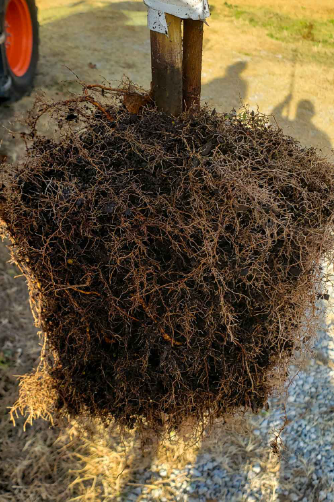Grow bags have gained popularity among gardeners and urban growers as a versatile, eco-friendly alternative to traditional pots and raised beds. Designed to provide optimal growing conditions for a wide variety of plants, grow bags can improve root health, maximize space, and give gardeners the flexibility to cultivate plants in small or unconventional spaces. Here’s a breakdown of why grow bags are beneficial and how they support different types of plants.
Improved Root Health with Air Pruning
One of the standout benefits of grow bags is their impact on root development. Traditional pots can cause plants’ roots to circle around the container, potentially leading to root-bound plants. Grow bags, however, encourage a process called air pruning, where roots naturally stop growing when they reach the edges of the bag. This allows the plant to develop a more fibrous, robust root system, improving nutrient uptake and overall plant health.
- Ideal for: Vegetables like tomatoes, peppers, and root crops such as carrots and potatoes, which thrive with healthy, extensive root systems.

Air pruned healthy roots

Circling roots from pots
Enhanced Drainage and Aeration
Fabric grow bags are designed to allow excess water to drain out while allowing airflow to the roots. This design helps prevent waterlogging, which can be common in traditional pots and can lead to root rot. The breathable material provides ample aeration to the roots, promoting oxygen flow and improving root metabolism. Our 4L growbags are the smallest size we carry and are perfect for lavender and rosemary. What’s great is they can be brought inside from the cold and ornamentation.
- Ideal for: Herbs and flowers that need well-drained soil, such as lavender, rosemary, and petunias.
Flexibility and Portability
Grow bags are lightweight and easy to move, which allows gardeners to optimize their garden layout by relocating plants for ideal sunlight exposure or protection from harsh weather. They’re also great for extending the growing season, as bags can be moved indoors or to sheltered areas as the temperature changes.
- Ideal for: Any plants that require specific light conditions, such as sun-loving vegetables like peppers, or shade-preferring plants like lettuce. This also makes grow bags suitable for smaller trees and fruit bushes that might need protection in colder months.

Indoor growing Hothouse tomatoes in fabric growbags
Space-Saving Design for Urban and Indoor Gardening
For those with limited outdoor space, grow bags offer a compact and efficient solution. Their flexible structure means they can be arranged in smaller areas, making them perfect for urban gardens, balconies, or even indoor spaces. Stackable or vertically arranged grow bags allow for more plants in a smaller footprint, maximizing the number of plants that can be grown in a limited area.
- Ideal for: Leafy greens, microgreens, herbs, and compact vegetables, which thrive in small spaces and are easy to harvest in compact environments.
Eco-Friendly and Sustainable
Grow bags are available in various eco-friendly materials, such as biodegradable options or reusable fabric. They reduce reliance on single-use plastic pots and are generally more sustainable than traditional planters. High-quality grow bags are durable, often lasting multiple growing seasons if cared for properly, making them a great choice for environmentally conscious gardeners.
- Ideal for: All plants, but especially those in home gardens focused on sustainability and reducing waste, such as native plants, pollinator-friendly flowers, and vegetables grown with organic methods.
Temperature Control and Root Zone Protection
The breathable fabric of grow bags helps regulate soil temperature. In hot weather, the material allows heat to escape, preventing overheating of the root zone. Conversely, in cooler climates, grow bags can be placed in sunny spots or even wrapped with insulating materials to keep roots warm, extending the growing season.
- Ideal for: Heat-sensitive plants like leafy greens (lettuce, spinach), as well as sensitive flowers and herbs that are prone to wilting in intense sun or heat.
Which Plants Grow Best in Grow Bags?
Most plants adapt well to grow bags, but certain plants particularly benefit from the advantages they offer. Here are a few popular choices:
- Vegetables: Tomatoes, peppers, potatoes, carrots, and onions
- Herbs: Basil, rosemary, thyme, and mint
- Flowers: Petunias, marigolds, and geraniums
- Fruits: Strawberries and small citrus trees
- Root Crops: Radishes, beets, and garlic
Tips for Maximizing Growth in Grow Bags
- Choose the Right Size: Select a grow bag size that matches the plant’s root system and growth requirements. For example, larger bags like our 24L growbags are ideal for tomatoes and root vegetables, while smaller bags are suitable for herbs.
- Monitor Watering: Due to enhanced drainage, grow bags may need more frequent watering than traditional pots. Checking soil moisture levels regularly is key.
- Use Quality Soil: Choose a nutrient-rich, well-draining soil mix to support healthy root and plant growth.
- Feed Regularly: Since grow bags allow for more frequent watering, essential nutrients may leach out faster. Adding organic fertilizers periodically can keep plants thriving.
Convenience & Cost-Saving
We also offer free pick up 3052 Hwy. 2, Bowmanville. See our contact page for more details
Elevate your gardening experience in Ontario with Darlington Garden’s premium selection of affordable growbags.
Unearth the potential of your garden today!
